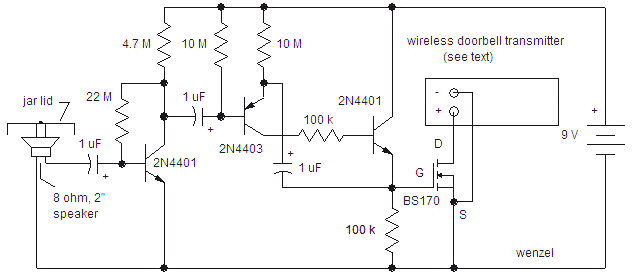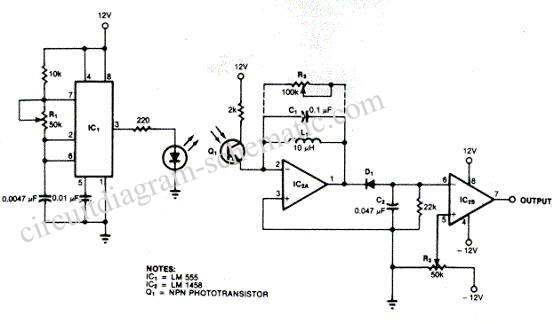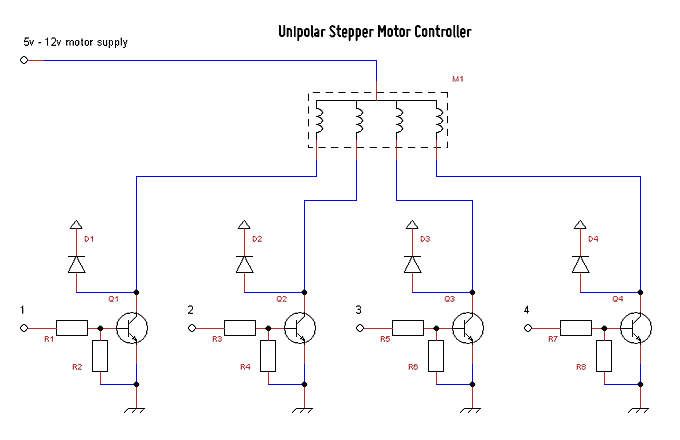
Deer Repellent/ Seismic Sensors

By attaching a standoff to the center of a 2-inch, 8-ohm speaker, it can be transformed into a vibration sensor with a natural resonance below 100Hz, which is quite effective. The implementation involves hanging the speaker from the lid of an empty instant iced tea jar after the epoxy has cured. Care should be taken when mounting the speaker, as the cone is fragile and cannot handle excessive torque during installation. It is advisable to apply epoxy to the screw threads near the head and to hand-tighten only. This will ensure a secure mount and also seal the hole. Flexible wires connect the speaker terminals to a circuit that operates similarly to an older design but does not utilize the now-obsolete CA3094 op-amp. This new design maintains high sensitivity and employs standard discrete components. The output can drive various devices such as buzzers or relays, with a preferred option being a Radio Shack wireless doorbell. The transmitter for this "wireless remote door chime" has connections on the back that parallel the pushbutton; shorting these contacts will activate the bell. One contact has a positive voltage near 9 volts and should connect to the drain of the FET, while the other should connect to the negative battery terminal. Brass standoffs can be used to elevate the circuit board above these terminals for mounting purposes. For different loads, such as a 9-volt buzzer, the negative end should connect to the drain and the positive end to the positive battery terminal. A separate battery can be utilized for powering the load if desired. In this case, the circuit is powered from the transmitter's battery, with two wires run out from the PCB where the battery wires are attached. The transmitter can remain unaltered if a separate battery is used. The transmitter is secured in the jar with a piece of styrofoam, and the lid is then screwed on. The circuit requires a minute or so to reach full sensitivity, after which even a slight jarring of the jar will ring the bell. The circuit also takes time to recover after being triggered. To cover a larger area, the sensor can be placed over a pipe buried just beneath the surface; any footstep along the pipe will activate the sensor. The 1µF capacitors can be of any type, although a 16-volt aluminum electrolytic is the most common choice. The amplifier stages will function with smaller values, and increasing the 1µF value on the gate of the MOSFET will extend the on-time if desired. The circuit is powered by a standard 9-volt rectangular battery, and no power switch is necessary due to the extremely low current drain. It is possible to share the battery with the transmitter. The doorbell transmitter is a Radio Shack wireless doorbell, but other models may also be suitable. If a model without rear contacts is used, two wires can be connected to the back of the pushbutton, and a voltmeter can be used to identify the wire with the positive voltage. The first transistor in the circuit serves as a low current, high gain audio amplifier, boosting the small signal from the speaker. When the signal increases due to vibration, it lowers the PNP base enough to slightly turn it on. This initiates regenerative action, fully activating it and the third NPN transistor. The voltage at the gate of the MOSFET rises, turning it on. The capacitor in the emitter of the PNP discharges, causing the transistor to switch off suddenly due to reverse regenerative action. Recovery time for the circuit can take several seconds before it is ready for another trigger. This simple sensor can detect seismic vibrations caused by nearby movement, such as a person or large animal walking, making it suitable for applications like a deer repellent.
The circuit design includes a basic vibration sensor using a speaker, which is sensitive to low-frequency vibrations. The speaker cone acts as the primary sensing element, resonating at low frequencies, which enhances its sensitivity to vibrations. The use of epoxy for mounting ensures durability and stability, preventing mechanical stress on the fragile cone. The circuit's design incorporates a low-power amplifier stage to boost the signal from the speaker, ensuring that even minor vibrations can be detected. The choice of components, such as the MOSFET and transistors, is critical for maintaining low power consumption while ensuring effective signal amplification and processing.
The output stage of the circuit is designed to interface with various devices, allowing for flexible applications depending on the user's needs. By utilizing a wireless doorbell transmitter, the system can provide a convenient alert mechanism when vibrations are detected, making it suitable for security applications or monitoring wildlife activity. The design's adaptability to different power sources and loads further enhances its versatility, allowing for a wide range of implementations in various environments.
In summary, this circuit exemplifies an innovative approach to creating a vibration sensor using readily available components, demonstrating the potential for simple electronic designs to fulfill practical applications in monitoring and alert systems.By gluing a standoff to the center of the cone, an inexpensive 2", 8 ohm speaker becomes a vibration sensor with a naturalresonance below 100Hz which is quite good. My implementation is shown below: After the epoxy cured, the speaker was hung in the middle of the lid from an empty instant ice tea jar.
Be careful mounting the speaker! The cone is weak and cannot tolerate a lot of torque when you tighten the screw. Put some epoxy on the screw threads near the head and hand-tighten only. The epoxy will provide a firm mount and will seal the hole, too. Flexible wires lead from the speaker terminals to the circuit: The circuit is similar in operation to my original design but without the now-obsolete CA3094 op-amp. This design is every bit as sensitive and uses ordinary discrete components. The output will drive any variety of buzzers, relays or other devices but my favorite is a Radio Shack wireless doorbell: This transmitter for this "wireless remote door chime" has a couple of connections on the back that are in parallel with the pushbutton and shorting these contacts causes the bell to ring.
One of the contacts has a positive voltage near 9 volts and this contact should go to the drain of the FET. The other should go to the negative battery connection. I used a couple of brass standoffs to space the circuit board above these terminals to mount the board.
If you want a different load (like a 9 volt buzzer), connect the negative end to the drain and the positive end to the positive battery terminal. You can use a different battery to power the load, if desired. I decided to power my circuit from the battery in the transmitter so I drilled a small hole in the back and ran two wires out from the PCB where the battery wires attached.
If you use a separate battery, the transmitter can be left "unmolested". I wedged the transmitter into the jar with a piece of styrofoam then screwed on the lid. It will take a minute or so before the circuit reaches full sensitivity. But then the slightest jarring of the jar will ring the bell! The circuit will take a while to recover after a trigger, too. To protect a large area with the sensor set it over a pipe buried just beneath the surface. A footstep anywhere along the pipe will shake the sensor. The 1uF capacitors may be just about any type, with a 16 volt aluminum electrolytic being the most likely choice. The amplifier stages will work with smaller values. Increase the value of the 1uF on the gate of the mosfet for a longer on-time, if desired. The battery is an ordinary 9 volt rectangular type and no power switch is needed because the current drain is extremely low.
You may share the battery in the transmitter. The doorbell transmitter is a Radio Shack wireless doorbell but others should be adaptable. If you find one without the rear contacts, connect two wires to the back of the pushbutton and use a voltmeter to determine which wire has the positive voltage. The first transistor is a very low current, high gain audio amplifier that boosts the tiny signal from the speaker.
When the signal is large enough, due to vibration, it pulls down the PNP base enough to turn it on slightly. Once that happens, regenerative action cause it and the third NPN to turn on fully. The voltage rises on the gate of the mosfet, turning it on. The capacitor in the emitter of the PNP discharges and the transistor turns off suddenly due to reverse regenerative action.
It takes many seconds for the circuit to recover and be ready for another trigger. Here is a simple sensor which can detect the seismic vibrations caused by a person or large animal walking nearby. A representative application for the sensor is a deer repellent for t 🔗 External reference
The circuit design includes a basic vibration sensor using a speaker, which is sensitive to low-frequency vibrations. The speaker cone acts as the primary sensing element, resonating at low frequencies, which enhances its sensitivity to vibrations. The use of epoxy for mounting ensures durability and stability, preventing mechanical stress on the fragile cone. The circuit's design incorporates a low-power amplifier stage to boost the signal from the speaker, ensuring that even minor vibrations can be detected. The choice of components, such as the MOSFET and transistors, is critical for maintaining low power consumption while ensuring effective signal amplification and processing.
The output stage of the circuit is designed to interface with various devices, allowing for flexible applications depending on the user's needs. By utilizing a wireless doorbell transmitter, the system can provide a convenient alert mechanism when vibrations are detected, making it suitable for security applications or monitoring wildlife activity. The design's adaptability to different power sources and loads further enhances its versatility, allowing for a wide range of implementations in various environments.
In summary, this circuit exemplifies an innovative approach to creating a vibration sensor using readily available components, demonstrating the potential for simple electronic designs to fulfill practical applications in monitoring and alert systems.By gluing a standoff to the center of the cone, an inexpensive 2", 8 ohm speaker becomes a vibration sensor with a naturalresonance below 100Hz which is quite good. My implementation is shown below: After the epoxy cured, the speaker was hung in the middle of the lid from an empty instant ice tea jar.
Be careful mounting the speaker! The cone is weak and cannot tolerate a lot of torque when you tighten the screw. Put some epoxy on the screw threads near the head and hand-tighten only. The epoxy will provide a firm mount and will seal the hole, too. Flexible wires lead from the speaker terminals to the circuit: The circuit is similar in operation to my original design but without the now-obsolete CA3094 op-amp. This design is every bit as sensitive and uses ordinary discrete components. The output will drive any variety of buzzers, relays or other devices but my favorite is a Radio Shack wireless doorbell: This transmitter for this "wireless remote door chime" has a couple of connections on the back that are in parallel with the pushbutton and shorting these contacts causes the bell to ring.
One of the contacts has a positive voltage near 9 volts and this contact should go to the drain of the FET. The other should go to the negative battery connection. I used a couple of brass standoffs to space the circuit board above these terminals to mount the board.
If you want a different load (like a 9 volt buzzer), connect the negative end to the drain and the positive end to the positive battery terminal. You can use a different battery to power the load, if desired. I decided to power my circuit from the battery in the transmitter so I drilled a small hole in the back and ran two wires out from the PCB where the battery wires attached.
If you use a separate battery, the transmitter can be left "unmolested". I wedged the transmitter into the jar with a piece of styrofoam then screwed on the lid. It will take a minute or so before the circuit reaches full sensitivity. But then the slightest jarring of the jar will ring the bell! The circuit will take a while to recover after a trigger, too. To protect a large area with the sensor set it over a pipe buried just beneath the surface. A footstep anywhere along the pipe will shake the sensor. The 1uF capacitors may be just about any type, with a 16 volt aluminum electrolytic being the most likely choice. The amplifier stages will work with smaller values. Increase the value of the 1uF on the gate of the mosfet for a longer on-time, if desired. The battery is an ordinary 9 volt rectangular type and no power switch is needed because the current drain is extremely low.
You may share the battery in the transmitter. The doorbell transmitter is a Radio Shack wireless doorbell but others should be adaptable. If you find one without the rear contacts, connect two wires to the back of the pushbutton and use a voltmeter to determine which wire has the positive voltage. The first transistor is a very low current, high gain audio amplifier that boosts the tiny signal from the speaker.
When the signal is large enough, due to vibration, it pulls down the PNP base enough to turn it on slightly. Once that happens, regenerative action cause it and the third NPN to turn on fully. The voltage rises on the gate of the mosfet, turning it on. The capacitor in the emitter of the PNP discharges and the transistor turns off suddenly due to reverse regenerative action.
It takes many seconds for the circuit to recover and be ready for another trigger. Here is a simple sensor which can detect the seismic vibrations caused by a person or large animal walking nearby. A representative application for the sensor is a deer repellent for t 🔗 External reference





